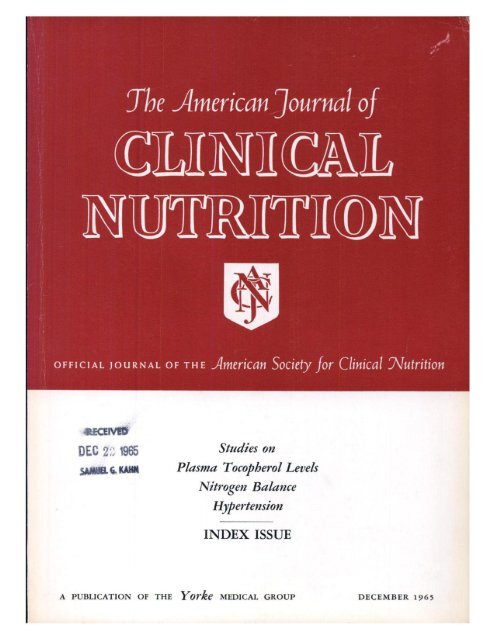Patterns of perinatal exposure to PUFAs and child neurodevelopment: evidence from Mendelian randomization using FADS cluster variants
IF 6.5
1区 医学
Q1 NUTRITION & DIETETICS
引用次数: 0
Abstract
Background
The potential causal effects of perinatal exposure to polyunsaturated fatty acids (PUFAs) on child neurodevelopment remains controversial.
Objective
To infer causation, we assessed the association of perinatal PUFA patterns and child neurodevelopment by using conventional regression analyses and 1-sample Mendelian randomization (MR).
Methods
Among 1096 mother–child pairs from the French Etude des Déterminants Pré- et Postnatals du Développement de la Santé de L’enfant cohort, patterns of perinatal exposure to PUFAs were previously identified combining PUFA levels from maternal and cord erythrocytes, and colostrum. Child verbal, performance, and full-scale intelligence quotients (IQs) were assessed at ages 5–6 y. Among maternal fatty acid desaturase (FADS) variants genotyped, 2 candidates, rs174546 (FADS1) and rs174634 (FADS3), were selected, as instrumental variables, for the MR analysis. The association of PUFA patterns with child IQ was examined by conventional multivariable linear regression and 2-stage least-squares MR regression.
Results
In the conventional approach, the first pattern “high omega-3 long-chain PUFAs (LC-PUFAs), low omega-6 LC-PUFAs” was positively associated with verbal IQ [β (95% confidence interval) = 1.24 (0.27, 2.21) points per 1 standard deviation (SD) increase in pattern] and full-scale IQ [1.11 (0.18, 2.05)]. This pattern was independent of FADS variants, rendering MR analysis inapplicable. The third pattern, “colostrum LC-PUFAs,” was positively associated with verbal [1.11 (0.19, 2.02)], performance [1.01 (0.09, 1.93)], and full-scale IQ [1.13 (0.25, 2.01)]. The MR approach, based on genetic instruments strongly associated with the third pattern, supported the beneficial effect on performance IQ [2.93 (0.05, 5.81) points per 1 SD increase in genetically predicted pattern]. The MR also suggested a deleterious effect of the fourth pattern “linoleic acid (LA) and dihomo-gamma-linolenic acid (DGLA)” on performance IQ [–1.66 (–3.22, –0.09)].
Conclusions
These findings supported the potential beneficial effects of perinatal exposure to LC-PUFAs on child neurodevelopment while highlighting possible adverse effects associated with exposure to LA and DGLA.
围产期暴露于PUFAs和儿童神经发育的模式:来自孟德尔随机化使用FADS簇变异体的证据
围产期暴露于多不饱和脂肪酸(PUFAs)对儿童神经发育的潜在因果影响仍然存在争议。目的通过常规回归分析和单样本孟德尔随机化(MR),评估围产期PUFA模式与儿童神经发育的关系,以推断因果关系。方法在来自法国研究人员的1096对母婴队列中,结合母体和脐带红细胞以及初乳的PUFA水平,确定围产期暴露于PUFA的模式。儿童在5-6岁时进行语言、表现和全面智商(iq)评估。在母体脂肪酸去饱和酶(FADS)基因分型中,选择rs174546 (FADS1)和rs174634 (FADS3)作为工具变量进行MR分析。采用常规多变量线性回归和2阶段最小二乘MR回归检验PUFA模式与儿童智商的关系。结果在常规方法中,第一种模式“高omega-3长链PUFAs (LC-PUFAs),低omega-6 LC-PUFAs”与言语智商[β(95%置信区间)= 1.24(0.27,2.21)分/模式(SD)增加1个标准差]和全面智商[1.11(0.18,2.05)]呈正相关。这种模式与FADS变体无关,因此MR分析不适用。第三种模式,“初乳LC-PUFAs”,与语言[1.11(0.19,2.02)],表现[1.01(0.09,1.93)]和全面智商[1.13(0.25,2.01)]呈正相关。基于与第三种模式密切相关的遗传工具的MR方法,支持对表现智商的有益影响[遗传预测模式每增加1 SD 2.93(0.05, 5.81)分]。MR还表明,第四种模式“亚油酸(LA)和二同γ -亚麻酸(DGLA)”对性能智商有有害影响[-1.66(-3.22,-0.09)]。结论:这些研究结果支持围产期暴露于LC-PUFAs对儿童神经发育的潜在有益影响,同时强调了暴露于LA和DGLA可能产生的不良影响。
本文章由计算机程序翻译,如有差异,请以英文原文为准。
求助全文
约1分钟内获得全文
求助全文
来源期刊
CiteScore
12.40
自引率
4.20%
发文量
332
审稿时长
38 days
期刊介绍:
American Journal of Clinical Nutrition is recognized as the most highly rated peer-reviewed, primary research journal in nutrition and dietetics.It focuses on publishing the latest research on various topics in nutrition, including but not limited to obesity, vitamins and minerals, nutrition and disease, and energy metabolism.
Purpose:
The purpose of AJCN is to:
Publish original research studies relevant to human and clinical nutrition.
Consider well-controlled clinical studies describing scientific mechanisms, efficacy, and safety of dietary interventions in the context of disease prevention or health benefits.
Encourage public health and epidemiologic studies relevant to human nutrition.
Promote innovative investigations of nutritional questions employing epigenetic, genomic, proteomic, and metabolomic approaches.
Include solicited editorials, book reviews, solicited or unsolicited review articles, invited controversy position papers, and letters to the Editor related to prior AJCN articles.
Peer Review Process:
All submitted material with scientific content undergoes peer review by the Editors or their designees before acceptance for publication.

 求助内容:
求助内容: 应助结果提醒方式:
应助结果提醒方式:


